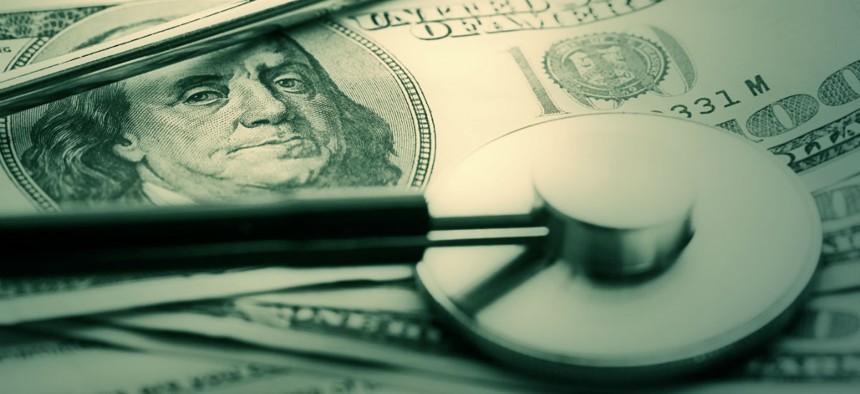
Feds Will Pay 6.2 Percent More Toward Health Care Premiums in 2017
The government's contribution will rise 3.7 percent.
This story has been updated.
Federal employees and retirees will pay an average of 6.2 percent more toward their health insurance premiums in 2017, the Office of Personnel Management announced Wednesday.
Federal Employees Health Benefits Program enrollees with self-only coverage will contribute an average of $5.27 more per paycheck, while those with family coverage will pay about $12.97 more. For just the second year, FEHBP participants can select the self-plus-one enrollment category. Those enrollees will see an average increase of $10.32 per paycheck.
Federal employees and retirees’ share of their health care premiums will go up by a higher percentage than the government contribution, which will rise 3.7 percent. OPM pays about 70 percent of FEHBP participants’ premiums.
Overall premiums for non-postal employees and annuitants, including all enrollment options and both the employee and government portions, will increase by 4.4 percent. The increase is down 2 percentage points from the 2016 increase, which was the largest since 2011. The jump had remained below 4 percent for five consecutive years before 2016.
John O’Brien, OPM’s director of health care and insurance, said at a press conference Wednesday the two primary factors in the increased rates were pharmaceutical costs and a rise in the average age of the federal workforce. He noted, however, the FEHBP increases were “at the low end of what is being experienced around the country.”
The consulting firm PricewaterhouseCoopers projected a 6.5 percent premium increase in 2017.
As mandated in OPM’s February carrier letter, all FEHBP health care plans will now provide appropriate benefits for children on the autism spectrum. There will be no other major changes to feds’ health care benefits in 2017, OPM officials said.
Next year’s exact increase will vary from plan to plan. The most popular plan -- the Blue Cross and Blue Shield Standard Option -- will see a $5.81 per paycheck increase for self-only enrollees. Family enrollees in the plan will pay an extra $15.99 per paycheck, and self-plus-one enrollees will pay $9.46 more. About 40 percent of FEHBP participants are enrolled in that plan.
U.S. Postal Service employees will pay an average of 11.7 percent more for their premiums -- or $16.32 per paycheck -- a slight decrease from the 2016 bump. Self-only enrollees will pay 11.5 percent more; self-plus-one, 12.9 percent; and self-and-family, 11.6 percent. The government share will increase by just 2.8 percent.
J. David Cox, president of the American Federation of Government Employees, said the premium increases were unacceptable.
“Like most other Americans, federal employees and retirees have seen their standards of living decline due to stagnant incomes and cost increases for basic goods and services,” Cox said. “This is an unacceptably high increase that will force many families to make difficult decisions about how to pay their bills.”
Richard Thissen, president of the National Active and Retired Federal Employees Association, said while the increases were “relatively modest,” they come at a time when feds’ long-term care insurance rates are set to skyrocket and pay raises have been historically small.
“For the seventh year in a row, the FEHBP premium increase also will take a bite out of the already reduced paychecks of federal employees,” Thissen said. “In the past six years, pay raises for federal employees have totaled a mere 3.3 percentage points. Yet FEHBP premiums have increased a total of 27.8 percentage points over the same time period.”
FEHBP will offer a total of 245 plan choices in 2017, seven fewer than it did in 2016. Every plan will offer self-only, self-plus-one and self-and-family enrollment options. The program added no new plans, while just five plans affecting 735 people will drop out of FEHBP next year. Fifteen plans will be offered to all participants regardless of where they live or work.
Last year, 3,000 enrollees were forced to find new health care plans due to terminations, and more than 25,000 had to shop for new options in 2015. O’Brien said the relatively small decrease in options for 2017 was “encouraging,” but OPM would have been “even happier” if new plans had entered FEHBP and increased competition.
About 8.2 million federal employees, retirees and their family members enroll in FEHBP. More than 1.7 million participate in the federal dental benefit, while 1.2 million enroll in vision plans. Premiums for the dental benefit will increase 1.9 percent in 2017, and those for the vision plan, 6.3 percent.
About 540,000 individuals opted into self-plus-one coverage in the first year OPM offered it, though O’Brien said upwards of 1 million enrollees would be better served in the offering compared to self-and-family.
Open season, the period in which federal employees and retirees can enroll in FEHBP or switch plans, will run from Nov. 14 through Dec. 12. Between 4 percent and 7 percent of enrollees typically switch plans annually. O’Brien projected this year’s open season would be “not as intense” as last year, when OPM created the new self-plus-one option.
CORRECTION: This story has been updated to fix an error in a statement from NARFE regarding the total percentage points FEHBP premiums have risen in the past six years.
NEXT STORY: 2017 FEHBP Premiums to Be Unveiled Wednesday






